 |
Scientific nameCyrtobagous salviniae Calder & Sands
Taxonomic positionColeoptera: Curculionidae: Stenopelmini
DescriptionLength: 1.5-3.1 mm; width: 1.2-1.6 mm. Body outline oval, dorsal side strongly convex,
freshly emerged adults light brown, turn dark brown to shiny, pitchy black after 3-4 days, antennae and legs reddish brown; inner surface of femora and tibiae, all tarsi, mesosternum, metasternum, and the basal two segments of abdomen covered with a grayish, velvet-like hydrofuge pubescence.
Body covered with scattered, small, round, metallic golden yellow, shield-like scales. Pronotum without any marked punctures. Elytra with large, very coarse, deep striae broader than the convex elytral intervals. Rostrum nearly straight and strongly swollen at, and in front of, the antennal insertion. All femora somewhat clavate, tibiae nearly straight, with a minute, but visible tooth on the inner apical surface. Tarsi five-segmented, last segment longer than segments 1-4 together. Tarsal claws free, approximate and very long. Elytra with rows of punctures and covered with yellow peltate scales. Females slightly larger than males. It has been confused with Cyrtobagous singularis (Hustache) in the literature. Sands (1983) clarified the identity of these two species. ImagesDistributionNative of South America and occurs naturally in southeastern Brazil, Bolivia, Paraguay and northern Argentina. Introduced in several parts of the world such as Australia, India, etc. Introduced in India in 1982. Well established in Kerala, particularly in Kuttanad, Trichur, and other areas where salvinia used to be a major problem.
BiologyCyrtobagous salviniae feeds on two species of Salvinia, namely, Salvinia molesta D.S. Mitchell and Salvinia minima Baker. Adults typically reside on or beneath the leaves or fronds of water fern. A thin film of air adheres to the bottom of the weevil allowing for respiration during periods of submergence. Eggs are laid individually in cavities formed by the female's feeding activity. Eggs hatch in about 10 days. The larvae are white and c-shaped. They feed on the leaves for two or three days and then bore into the stem or unopened leaves. There are three instars, which are completed in 22-25 days. Pupation takes place in a cocoon loosely in contact with the plant tissue beneath the water surface. Pre-pupal and pupal periods are completed in 3 and 8-10 days, respectively. Adults live for about 60 days.
Symptoms of damageAdults feed on the young terminal leaves and unopened leaves, leaving small, irregularly shaped holes, but prefer feeding on newly formed leaf buds. First instar larvae feed on the buds or roots, while second and third instar larvae tunnel within the apical rhizomes. The affected leaves turn brown and then finally drop off. The weed mat decays and sinks upon sustained feeding.
Mass productionMass production can be done on water fern mats in plastic-lined portable water tanks. Detailed production procedure is given by Singh (1995). Studies in Australia indicate that applying nitrogen in the form of urea either directly or indirectly to the plants significantly increases the chance
for establishment and initial population build-up.
References
|






